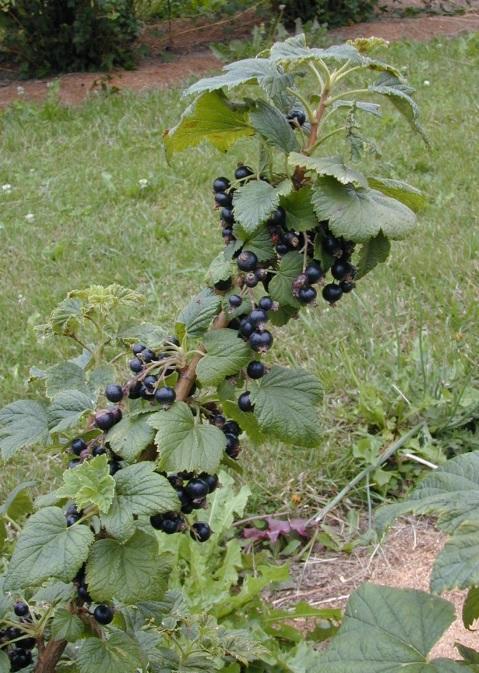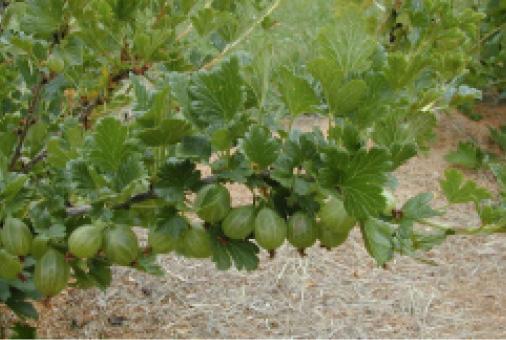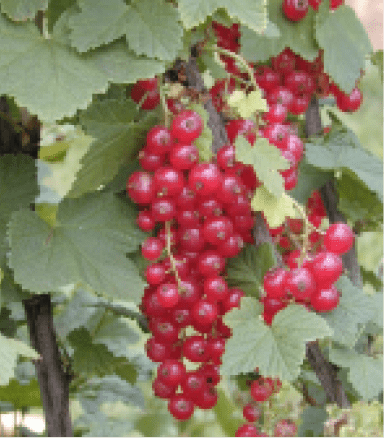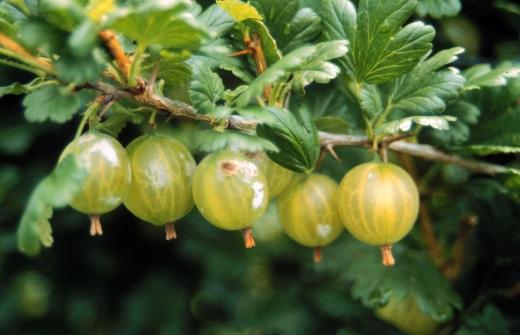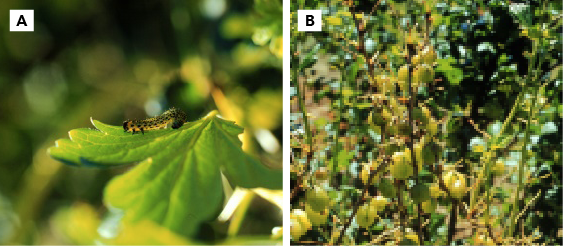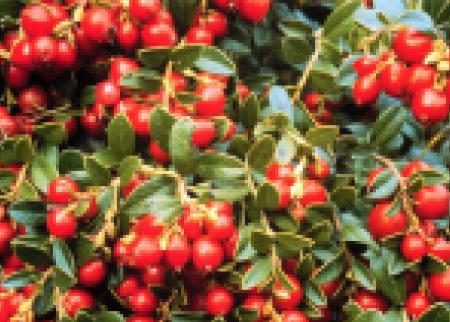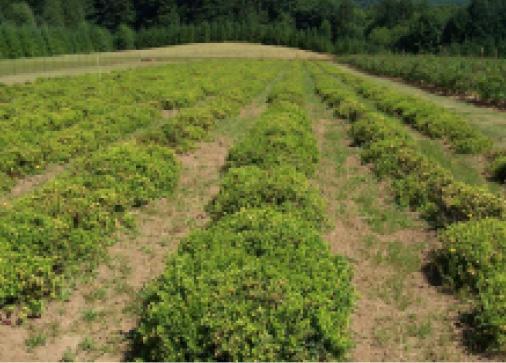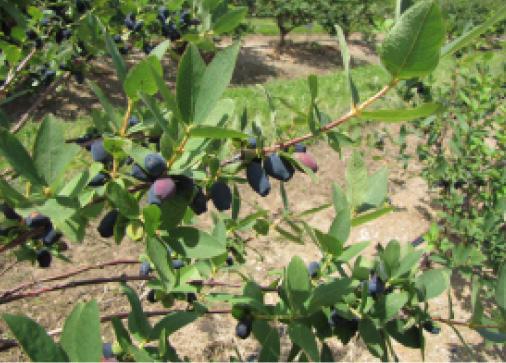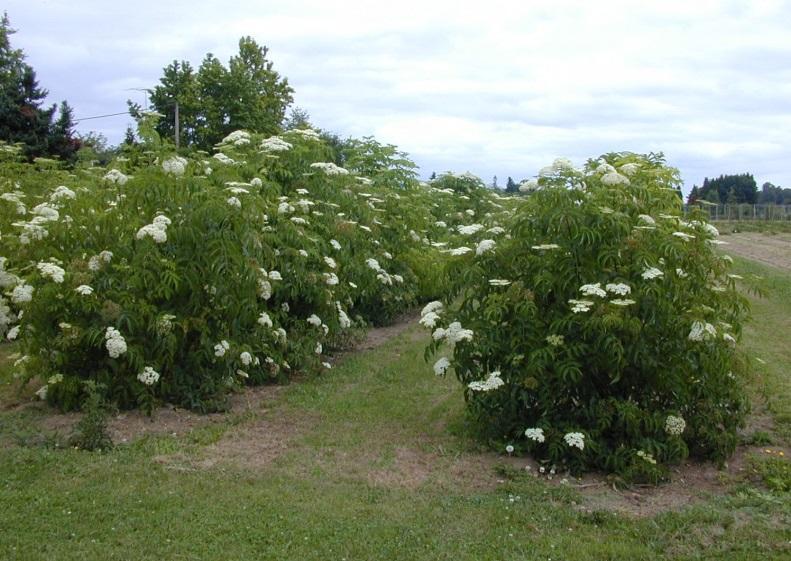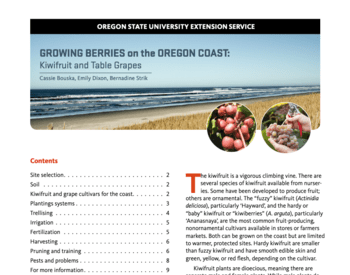Gooseberries and currants
Gooseberries and currants are small shrubs in the genus Ribes. There are black, red, and white currants. Black currants (Figure 1, page 2) are primarily used in juice, jam, jelly, pies, and liqueurs. Red currants (Figure 2, page 2) are usually used only for fresh eating, jelly, or wine. White currants are not as popular as red or black currants but can be used similarly. Gooseberries (Figure 3, page 2) have red or yellow-green fruit and can be used fresh or in jam, pies, and desserts. Currants and gooseberries both freeze well. Jostaberry berry cultivars (a cross between a gooseberry and a black currant) have not yielded well in test plots in Oregon.
Gooseberries and currants (and other Ribes species) are an alternate host for white pine blister rust, which affects five-needled pines. If you have these trees in your landscape, you should avoid planting Ribes or pick cultivars that are resistant to the disease.
Red currants and gooseberries generally are self-fruitful, so you need only one cultivar for fruit production. However, both types may produce larger fruit if you plant more than one cultivar for cross-pollination. Some black currants are self-sterile and require a second cultivar for fruit production. The cultivar selection available from local and mail order nurseries varies a great deal; check the descriptions for resistance to powdery mildew and white pine blister rust and comments on self-fertility.
Conditions for growing gooseberries and currants are similar to the more commonly grown berry crops (e.g., strawberries, raspberries, and blackberries). They prefer a soil pH of 5.6 to 6.5. Space gooseberries and red currants 3 to 4 feet apart in the row, and black currants 4 to 5 feet apart. Rows should be 8 to 10 feet apart. Black currants can be established in a hedgerow instead of as individual plants. For a hedgerow, space plants 2.5 to 3 feet apart in the row.
If the plants are small (less than 1 foot tall and growing in less than a 1-gallon sized container), prune all branches to 4 to 6 inches at planting. For larger plants, prune any weak growth from the base of the plant, strip or prune off the blossoms to encourage good vegetative growth, and cut back long, “leggy” branches. Apply 0.5 ounce nitrogen (N) fertilizer per plant two weeks after planting. In the second year, fertilize with 0.5 ounce N fertilizer per plant at bud swell in the spring; watch growth to see if more fertilizer is needed. Increase the rate slightly in the third year, and in the fourth year apply 1 ounce N per plant, split between bud break and mid- to late June.
Plants should be pruned when dormant in late winter. Red currants and gooseberries produce most of their fruit on spurs on 2- and 3-year-old wood (Figure 4, page 3). Remove canes that are 4 or more years old from the base of the plant. A healthy bush should be pruned to 9 to 12 main canes, divided equally between 1-, 2-, and 3-year-old canes. Remove damaged or diseased canes. Prune to form an open center and remove canes that are low to the ground. Black currants produce most of their fruit on 1-year-old wood like blueberries. Vigorous 1-year-old shoots and 2- or 3-year-old canes with strong 1-year-old shoots are the most productive. Keep 10 to 12 canes per bush; half should be 1-year-old shoots.
You can harvest a light crop the year after planting and should have mature production by the third or fourth year. Currants ripen over a 2-week period and can hang on the bush for a week after they are ripe and before they become overripe, allowing for only a few harvests. Gooseberries ripen over a 4- to 6-week period. Black currants and gooseberries can be harvested as individual berries. Red currants must be harvested by picking the whole cluster (called a strig). The berries can be stripped from the stem just prior to eating or processing. To make jellies, freeze the strigs and then knock off berries before crushing the fruit. Gooseberries are delicious when ripe; the fruit softens during the later stages of ripening.
The most common disease problems with currants and gooseberries are powdery mildew (Figure 5) and anthracnose leaf spot. Powdery mildew resistant cultivars are available. The most common insect problems in currants are aphids, currant fruit flies (also known as gooseberry maggots), currant and gooseberry-imported currant worm (Figures 6A and B), and currant borers.
Lingonberries
The lingonberry (Vaccinium vitis-idaea) (Figure 7, page 4) is closely related to the cranberry and blueberry. The fruit are red like cranberries, but pea-sized and sweeter, although still rather tart. The seeds, like those of blueberries, are not very noticeable. Other common names for this berry are cowberry, moss cranberry, mountain cranberry, and red whortleberry. The lingonberry is a woody, evergreen dwarf shrub (about 1 to 1.5 feet tall) native to northern temperate, boreal, and subarctic areas. Lingonberries are harvested from the wild in Scandinavia and Russia, and grown commercially in central Europe and (to a very small extent) in Oregon. Lingonberry fruit can be used for juice, jelly, preserves, and sauce. Lingonberry sauce is a great accompaniment to meat dishes. The plants also make attractive ornamental shrubs.
Through the production of underground rhizomes, lingonberries evenutally form a solid row (Figure 8, page 4), much like strawberries. Plantings remain productive for more than 15 years. Choose more than one cultivar because lingonberries need a pollinizer for fruit production. ‘Red Pearl’ is a wide, bushy plant that is about 1 foot tall. Fruits are from ¼ to ½ inch in diameter and bright red. They ripen in September to October. ‘Koralle’ is a wide plant reaching about 1 foot in height. It spreads by rhizomes more slowly than most cultivars. Fruits are light to dark red in color. ‘Erntedank’ originated in the wild in Germany. It exhibits moderate growth and small- to medium-size fruit. It is very productive, producing both a spring and summer crop.
Lingonberries normally produce two crops per year—one in summer and one in fall. Total annual yield typically is 0.5 to 1 pound per plant. Sometimes, the blossoms for the summer crop are damaged by spring frost, leading to a single fall crop.
Lingonberries are not easy to grow because they require an acidic soil (like blueberries) and are often over fertilized or over irrigated. Follow the pre-planting recommendations for blueberry. See Growing Berries on the Oregon Coast: Blueberries (EM 9179).
Space plants 1 to 1.5 feet apart and rows 3 feet apart. Lingonberries do not need high rates of fertilizers and will die back if fertilized too heavily. In the first 5 years, apply 20 to 40 pounds nitrogen (N) per acre (2 to 4 ounces N per 100 feet of row). Apply 40 pounds N per acre (4 ounces N per 100 feet of row) in subsequent years. Mulch plantings with sawdust, following recommendations for blueberries, with no more than a 3-inch-deep mulch.
Do not prune lingonberries the first 4 years after planting. Beginning when the plants are 5-years-old, mow alternate rows to a height of 2 inches every 3 to 6 years. See the Lingonberry Production Guide for the Pacific Northwest (PNW 583) for more information.
The Western spotted cucumber beetle, the Western striped cucumber beetle, and the oblique-banded leafroller have been observed feeding on lingonberry leaves, but few major insect pests have been observed in Oregon. Disease problems include several pathogenic fungi that must be identified by laboratory analysis. See the Pacific Northwest Plant Disease Management Handbook for more information.
Haskap berries
Haskaps (Lonicera caerulea) are also sold as “honeyberries” by some nurseries. Cultivars originate from Japan (generally thought to be the best) or Russia. This is a relatively new crop for small farms or home gardens, producing oval-shaped dark blue, tart berries that ripen before June-bearing strawberries (Figure 9). The small, yellow flowers are very tolerant to frost. Most cultivars are not self-fruitful, so you will need a pollinizer. Plants should be spaced 3 feet apart for a hedge or 4 to 4.5 feet apart for separate plants. Rows should be 8 to 10 feet apart. Bushes should be pruned in late winter to remove older branches and open up the plant. Remove less than a quarter of the plant in one year. Powdery mildew and birds can be problems in haskaps. For more information see https://ediblebluehoneysuckle.wordpress.com/.
Elderberries
There are many species of elderberry native to North America. The species that is commercially grown in some regions is Sambucus canadensis. All parts of the elderberry have been used at some time in medicine. The fruit can be used for juice, sauces, jelly, and wine. Their flowers (Figure 10) can also be used to flavor drinks or may be battered and fried, similar to squash flowers.
Often, elderberries sold through nurseries are not distinguished by a cultivar name. Cultivars commonly sold include ‘Adams,’ ‘Nova,’ and ‘York.’ Although these cultivars are partially self-fruitful, they all will benefit from cross-pollination.
Elderberries prefer full sun and grow in a wide range of soil types—from quite wet to dry. However, plants grow best in well-drained soil with a pH between 5.6 and 6.5. Plants may grow to a height of 12 feet. Establish plants in the spring. Space them 5 to 6 feet apart in the row, with 12 to 13 feet between rows. No fertilizer is needed in the planting year. Starting the second year, apply 1 ounce of nitrogen per year of plant age, up to a maximum of ½ pound per plant. Use a well-balanced fertilizer.
Elderberries produce large fruiting clusters at the tip of the current season’s growth. The most productive wood is 2 or 3 years old. When pruning, remove weak and damaged canes and leave equal numbers of 1-, 2-, and 3-year-old canes. Remove canes more than 3 years old. Leave a total of about 9 canes per plant.
At full production, in 3 or 4 years, you can expect about 12 to 15 pounds of fruit per plant. Fruit are ripe from mid-August to mid-September, depending on the cultivar and growing location. Clusters ripen over a period of 5 to 15 days. Harvest the entire fruit cluster and quickly process or freeze. It is impossible to harvest individual fruit without losing too much juice.
Elderberries are generally free of pest and disease problems, although they can occasionally get powdery mildew; some cane borers attack them.
Aronia berries
Aronia berries (Aronia melanocarpa) are unfortunately known as the “chokeberry” and is not to be confused with the chokecherry (Prunus sp.). This berry crop produces many small, blue fruits. The plants also have outstanding fall leaf color, making them a great plant for the edible landscape (Figure 11). Fruit will hang on the plant if not picked, making them an excellent food source in the late-season for birds. The chokeberry is grown commercially in Eastern Europe and in some parts of the Midwestern United States for juice because the fruit are intensely colored. Cultivars available include ‘Nero’ and ‘Viking’.
Aronia berries grow best in a site with full sun. Plants have very similar soil requirements as blueberries. They can tolerate wet soil but not drought. Space plants about 6 feet apart. The crowns will grow to as much as 6 to 9 feet in diameter. Plants grow to about 7 feet tall.
Apply about 2 ounces of nitrogen (N) per plant in the establishment year and, unlike other plants, reduce the fertilizer rate to 1.5 ounces N in subsequent years. Apply half of the fertilizer in March and the other half in May.
Plants fruit on last year’s growth. Unlike blueberries, very little pruning is required other than thinning out the bush every 5 to 8 years.
Fruits ripen at the end of August or early September, with the season lasting about 10 days. About 15 to 20 small berries are produced per cluster. Harvest the entire cluster and freeze before knocking off the berries or making juice. Yields are about 20 pounds per bush.
Serious pest and disease problems have not been reported in Aronia berries.
Coastal edible natives
There are many tasty, edible native berries that can be found along the coast and in the coastal mountain range, including:
- Strawberry: Chilean strawberry (Fragaria chiloensis), mountain or Virginian strawberry (F. virginiana)
- Raspberry: thimble berry (Rubus parviflorus), salmon berry (R. spectabilis), and native black raspberry (R. leucodermis)
- Blackberry: native dewberry (R. ursinus; note that ‘Himalaya’ and ‘Evergreen’ are introduced weeds)
- Elderberry: blue elderberry (Sambucus caerulea)
- Service berry (Amelanchier alnifolia, also called Saskatoon berry or June berry)
- Blueberry: note that the following are commonly called huckleberries but are native blueberries [Vaccinium sp.—the evergreen huckleberry (V. ovatum) (Figure 12) and the red huckleberry (V. parvifolium)]
There are many other native berries, for example, gooseberry and currant (Ribes sp.) Oregon grape (Mahonia aquifolium) and salal (Gaultheria shallon) are edible, although they have more limited uses. Refer to the Oregon Flora Project (www.oregonflora.org) for more information on native plants.
Additional resources
- Oregon Flora Project www.oregonflora.org
- Edible Blue Honeysuckle Gardenershttps://ediblebluehoneysuckle.wordpress.com/
© 2016 Oregon State University.
Extension work is a cooperative program of Oregon State University, the U.S. Department of Agriculture, and Oregon counties. Oregon State University Extension Service offers educational programs, activities, and materials without discrimination on the basis of race, color, national origin, religion, sex, gender identity (including gender expression), sexual orientation, disability, age, marital status, familial/parental status, income derived from a public assistance program, political beliefs, genetic information, veteran’s status, reprisal or retaliation for prior civil rights activity. (Not all prohibited bases apply to all programs.) Oregon State University Extension Service is an AA/EOE/Veterans/Disabled.

